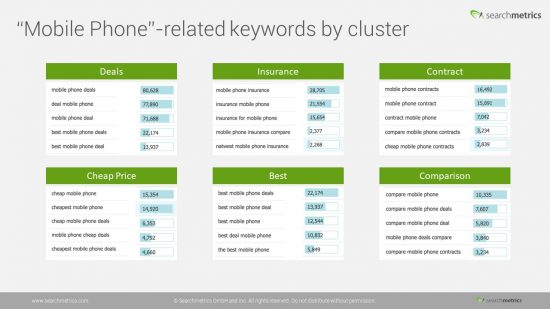If you want to perfectly serve the needs and interests of your users, you need a clear content strategy. In this article, I would like to show you how you can research different user interests by analyzing the relevant person groups and their needs throughout the stages of the sales funnel. I am Felix Oey. As a Senior SEO Consultant with the Searchmetrics Digital Strategies Group, I help our customers to optimize their content in accordance with user needs, so that they can improve their performance in organic search.
The topic of this piece is persona-based content creation, which I can explain using a business case I’ve researched. To do this, I analyzed user needs, the sales funnel and online competition for the topic “mobile phone” in Great Britain. Based on this analysis, I continued the example by creating a sustainable online strategy – enjoy reading, and I hope you can successfully adapt this strategy to your industry!
How-to Video: Persona-based Content Creation
If you prefer audio-visual content, you can watch this webinar that I and my boss, Björn Beth, Director of the Searchmetrics Digital Strategies Group, recently recorded on the topic of persona-based content strategies. You can find the video on our YouTube channel:
4 Steps to Persona-Based Content Creation
In case anyone doesn’t have half an hour right now to watch the webinar, I’ve summarized the most important points in this post. The starting hypothesis for my approach was: By identifying content clusters and defining relevant personas, you can shape your content and SEO strategy around each persona in the user journey. This makes it easier to plan new SEO campaigns or to optimize existing clusters on your website – and this will bring an increase in conversion rates.
1. Find the Top of Funnel
If you are looking to create the perfect content strategy, you first need to understand the intentions of your (target) users, so that your site can give them what they’re looking for. This puts the Top of Funnel at the heart of our strategy creation, as this is where the largest search volume is found. At the same time, many brands struggle when developing a content strategy to look beyond their own goals and company targets, and instead prioritize the needs of their users when creating landing pages.
Here’s a quick “Sales Funnel 101“: The sales funnel is made up of three phases. As you move down the funnel, the search volume decreases, but the conversion rate increases:
- Top of Funnel (TOFU): Product Research
- Middle of Funnel (MOFU): Product Purchase
- Bottom of Funnel (BOFU): Product Accessories
If you would like to learn more about the sales funnel, you can watch this webinar. In “The ROI Guarantee for your Content: Sustainable. Successful. Scalable.”, Björn Beth and Svetlana Stankovic, Team Lead SEO Consulting with the Searchmetrics Digital Strategies Group, explain how you can measure and scale your investment in digital content:
Now back to this post on strategy and our focus on the creation of a user persona map. First, we need to find out the main intentions our users have at the Top of Funnel. To do this, we can research the market structure – this gives us insight into the primary motivations of all users and provides a foundation for the creation of our content strategy.
For this analysis, I have taken a look at the online smartphone market in the UK. The most important Top of Funnel opportunities for our main topic, “mobile phone”, can be divided into three categories:
- Mobile phone without contract
- Mobile phone with contract
- SIM-only contract
2. Creating and Mapping Persona Clusters
Looking at the different offers, we can differentiate between three areas of user intent when thinking about personas at the Top of Funnel:
- Comparison
- Deals
- Price
We can go deeper within these areas, looking at a range of conditions, motivations and user groups: A user could belong to one (or more) of the following groups: elderly, young, price-sensitive, techy or business consumers. Whilst one user might want to research the best deals, other users – or personas – will be more interested in particular technical features, such as the size of the phone’s display or the quality of its camera.
You’re probably wondering how I found these different persona groups. It works easiest – and best – if you map the keywords using something like the Searchmetrics Research Cloud. Here, I can cluster my main topic into various sub-topics or user motivations. Google Suggest can also be used to help find sub-topics and motivations. The next step is grouping the keyword and search data to precisely see which user group has which needs – and how high each search volume is. In our example, mapping the keyword clusters for the main topic, “mobile phone”, looks like this:
3. How the Persona-based User Journey works
A content strategy built around a persona-based user journey analysis will help with the creation of a landing page that can – from both a content and empathy perspective – perfectly appeal to the user it is aimed at. A landing page like this will start by answering the persona’s questions – and only then offer an opportunity to convert – in our mobile phone example this could be an offer for a particular contract.
Sounds logical, right? Yet many large brands fail to do precisely this. Instead, the websites of big companies and providers are full of lists of offers but leave the user to fend for themselves in their search for information. If I show the user an offer – however attractive it may be – while they are still in a phase of their journey where they are looking for information, then this user is likely to look elsewhere.
Before creating the landing page, I can research the different user intents by clustering keywords in a smart way. Imagine there is a user who is looking for a SIM-only contract. If the landing page first provides relevant information that directly appeals to the user and their motivation – and then presents them with an appropriate offer, then revenue can be significantly increased.
4. Creating the right content
When creating content, it has to be tuned to the needs of the precise target audience – and not follow a “one-size-fits-all” approach. For the major phone companies this means: Don’t just present offers and phone models, create pages that match the needs of your personas. There is an enormous amount of potential here for brands: Helpful, relevant content – that provides much more information than offers and product listings – can far better answer queries that customers have.
Take-aways
Find your main keywords – cluster your topics – define your target groups – create tailored content. I hope you found this quick run through the concept of a persona-based content strategy useful. For more detailed information and step-by-step instructions, I recommend you take a look at the full webinar – or request a content audit from our Digital Strategies Group:


